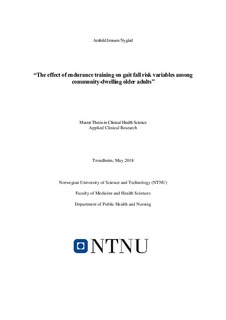| dc.description.abstract | Background: Gait is an essential part of human mobility and an important feature of quality of life. One third of people above 65 years fall each year and most falls among older adults happen during walking. Some gait characteristics are associated with a higher risk of falling and have even been able to distinguish a faller from a non-faller. Studies have shown that exercise focusing on balance and muscle strength can improve gait and reduce the risk of falls among older adults with an already established risk of falling.
Purpose: The aim of this study is to investigate if regular cardiovascular exercise can prevent a deterioration of gait characteristics associated with an increased risk of falls among healthy community dwelling older adults compared to controls.
Material and method: 1567 community dwelling older adults (72.5 ± 2.1 years) were randomized to either a control group (CON) or a high intensity training (HIT) or moderate intensity training (MIT) group. The participants where tested with a computerized walkway at baseline (GAITRite) and after three years intervention (Zeno).
Results: Overall there was a deterioration in most gait characteristics, but HIT had significant better scores for gait speed, step length and stance time for both fast and preferred condition when compared to CON, and in preferred condition when compared to MIT.
Conclusion: It seems as high intensity training can prevent a deterioration of certain mean gait characteristics related to fall risk among community dwelling older adults, while endurance exercise had no effect on gait variability measures. This study has confirmed that training has to be more specific to maintain most gait variables and therefore reduce the risk of falls.
Relevance
Falls are a major expense within health care, and those who fall experience injuries, loss of mobility, fear and reduced quality of life. An increased knowledge about how to prevent falls among healthy older adults is important. If we could prevent or delay the first fall this will reduce the burden on the health care services and maintain quality of life among older adults. | nb_NO |
